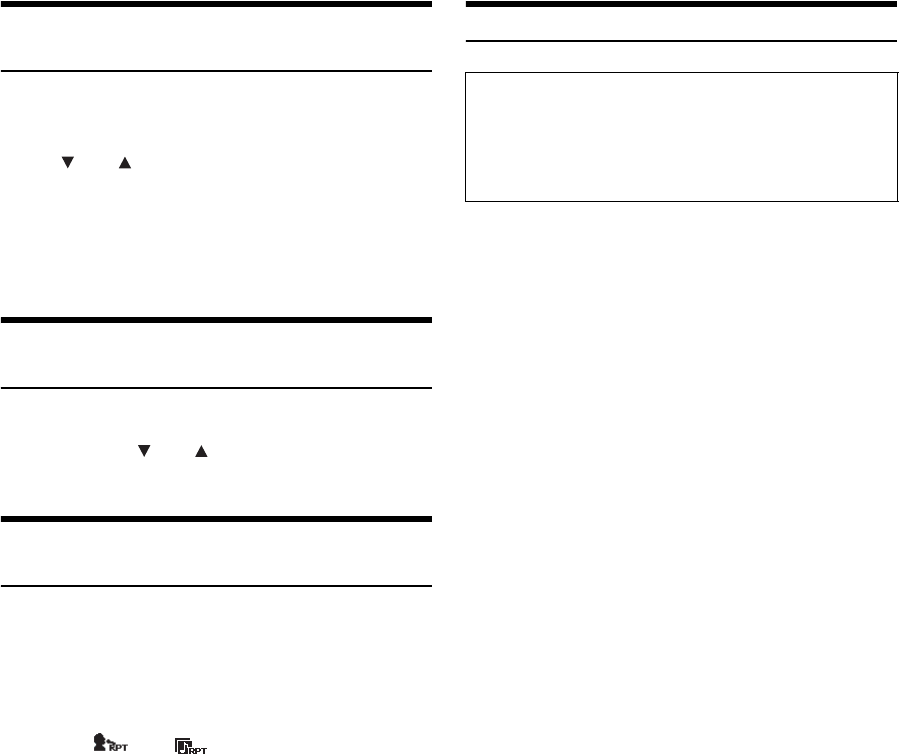
54-EN
Selecting Playlists/Artists/Albums/
Genres/Composers
Playlists/Artists/Albums/Genres/Composers can be easily changed.
For example, if you listen to a song from a selected album, the album
can be changed.
Touch [ ] or [ ] to select the desired Playlists/Artists/
Albums/Genres/Composers.
• If search selection mode is not activated, a Songs search is not
possible.
• If an album is selected from an artist search, the album can be
searched.
• During shuffle (M.I.X.) playback, this operation is not possible.
Select the desired Folder (Folder up/
down)
If you listen to a file from a selected folder, the folder can be changed.
Touch FOLDER [ ] or [ ] to select the folder.
• During shuffle (M.I.X.) playback, this operation is not possible.
Creating the playlist from the Artist/
Album information of the current song
When a song is played back, a playlist about all the songs with the same
Artist or Album stored in the USB memory or Portable audio player can
be created.
1
Touch [P1/2] when a song is played back.
The function guide changes.
2
Touch [ ] or [ ] to create the playlist.
• According to the artist/album information of the current song, a
playlist about all the songs with the same artist/album of the BANK
are made into a playlist, which then starts to play back.
About MP3/WMA/AAC
What is MP3?
MP3, whose official name is “MPEG-1 Audio Layer 3,” is a
compression standard prescribed by the ISO, the International
Standardization Organization and MPEG which is a joint activity
institution of the IEC.
MP3 files contain compressed audio data. MP3 encoding is
capable of compressing audio data at extremely high ratios,
reducing the size of music files to as much as one-tenth their
original size. This is achieved while still maintaining near CD
quality. The MP3 format realizes such high compression ratios
by eliminating the sounds that are either inaudible to the human
ear or masked by other sounds.
What is AAC?
AAC is the abbreviation for “Advanced Audio Coding,” and is a
basic format of audio compression used by MPEG2 or MPEG4.
What is WMA?
WMA, or “Windows Media™ Audio,” is compressed audio data.
WMA is similar to MP3 audio data and can achieve CD quality
sound with small file sizes.
Method for creating MP3/WMA/AAC files
Audio data is compressed by using MP3/WMA/AAC specified
software. For details on creating MP3/WMA/AAC files, refer to
the user’s manual for that software.
MP3/WMA/AAC file extensions that can be played back on the
unit are as follows:
MP3: “mp3”
WMA: “wma” (ver. 7.1, 8, 9, 9.1, 9.2 supported)
AAC: “m4a”
WMA is not supported for the following files, Windows Media
Audio Professional, Windows Media Audio 9 Voice or Windows
Media Audio 9 Pro Lossless.
Depending on the software that is used to create AAC, the file
format may differ from the extension.
Playback of AAC files encoded by iTunes is supported.
Supported playback sampling rates and bit rates
MP3
WMA
AAC
This device may not play back correctly depending on sampling
rates.
The playback time may not be correctly displayed when a VBR
(Variable Bit Rate) recorded file is played back.
CAUTION
Except for private use, duplicating audio data (including MP3/
WMA/AAC data) or distributing, transferring, or copying it,
whether for free or for a fee, without permission of the copyright
holder is strictly prohibited by the Copyright Act and by
international treaty.
Sampling rates: 48 kHz, 44.1 kHz, 32 kHz, 24 kHz, 22.05 kHz,
16 kHz, 12 kHz, 11.025 kHz, 8 kHz
Bit rates: 32 - 320 kbps
Sampling rates: 48 kHz, 44.1 kHz, 32 kHz, 24 kHz, 22.05 kHz,
16 kHz
Bit rates: 16 - 320 kbps
Sampling rates: 48 kHz, 44.1 kHz
Bit rates: 8 - 576 kbps


















